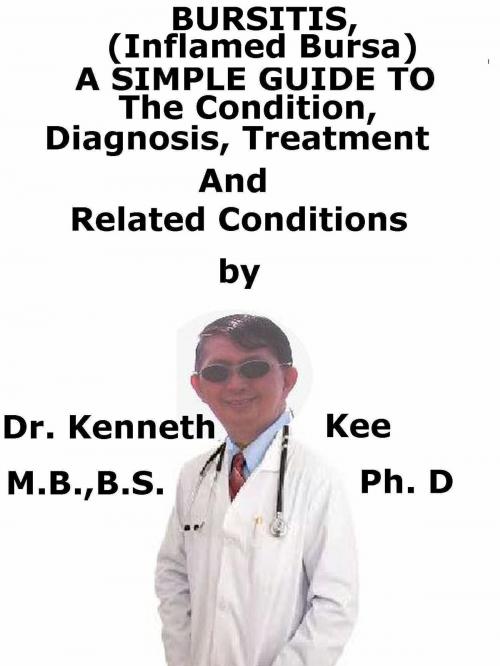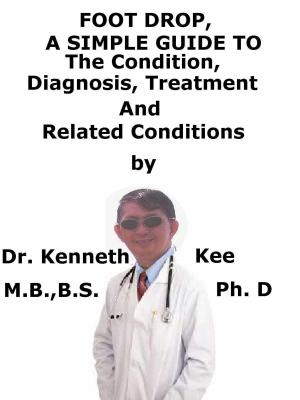Bursitis, (Inflamed Bursa) A Simple Guide To The Condition, Diagnosis, Treatment And Related Conditions
Nonfiction, Health & Well Being, Health, Ailments & Diseases, Musculoskeletal, Medical, Specialties, Orthopedics| Author: | Kenneth Kee | ISBN: | 9781370991839 |
| Publisher: | Kenneth Kee | Publication: | February 22, 2017 |
| Imprint: | Smashwords Edition | Language: | English |
| Author: | Kenneth Kee |
| ISBN: | 9781370991839 |
| Publisher: | Kenneth Kee |
| Publication: | February 22, 2017 |
| Imprint: | Smashwords Edition |
| Language: | English |
Bursitis is the medical disorder of inflammation or irritation of the bursa.
The bursa is a sac containing lubricating fluid, located between tissues such as bone, muscle, tendons, and skin that reduce rubbing, friction, and irritation.
The bursa is a fluid-filled sac that works as a cushion between a muscles, tendons, and bones.
Occasionally the cause may not be found.
Bursitis often happens in the shoulder, knee, elbow, and hip.
Other regions that may be involved are the Achilles tendon and the foot.
Bursitis is most often produced by repetitive, minor injury on the area, or from a sudden, more serious trauma.
1. An atypical or poorly placed bone or joint (such as length sizes in the legs or arthritis in a joint) can place added stress on a bursa sac, causing bursitis.
2. Stress or inflammation from other disorders, such as rheumatoid arthritis, gout, psoriatic arthritis, thyroid disorders, or abnormal medicine reactions may also raise a person's risk.
3. Also, an infection can sometimes result in inflammation of a bursa.
4. The most frequent causes of bursitis are repetitive movements or locations that cause irritation of the bursae around a joint:
a. Throwing a baseball or lifting something over the head repeatedly
b. Leaning on the elbows for long periods
c. Extensive kneeling for tasks such as laying carpet or scrubbing floors
d. Prolonged sitting, especially on hard surfaces
The most frequent locations for bursitis are in the shoulder, elbow and hip.
But the patient can also have bursitis by the knee, heel and the base of the big toe.
Symptoms of bursitis may be:
1. Joint pain and tenderness when the patient pushes around the joint
2. Stiffness and aching when the patient moves the affected joint
3. Swelling, warmth or redness over the joint
Doctors can often diagnose bursitis based on a medical history and physical exam.
X-ray images cannot positively confirm the diagnosis of bursitis, but they can assist ruling out other causes of the discomfort.
Ultrasound or MRI may be done if the bursitis cannot easily be diagnosed by a physical exam alone.
Magnetic resonance imaging (MRI) may be done to exclude tissue injury, such as a torn tendon (tendons are the cords that join bones to muscles)
Bursitis treatment normally requires conservative measures, such as rest, ice and taking a pain reliever such as aspirin, paracetamol and ibuprofen.
1. Rest the joint until the symptoms get better and prevent any strenuous activities that tend to cause more pain, such as running.
2. Wearing padding may help prevent the joint from more injury.
Knee pads may help if the patient has bursitis in the knee joints.
3. Ice packs are also a good method of reducing inflammation and pain.
4. When sleeping, do not sleep on the side that has bursitis.
If conservative treatments do not work, further treatment may be:
1. Medicine
Non-steroidal anti-inflammatory drugs (NSAIDs), such as ibuprofen can relieve pain
If the inflammation in the bursa is produced by an infection, the doctor might prescribe an antibiotic.
2. Physical Therapy
The doctor may advise physical therapy or exercises to strengthen the muscles in the involved area to ease pain and prevent recurrence.
3. Injections
The doctor may inject a corticosteroid medicine into the bursa to alleviate inflammation in the shoulder or hip.
This treatment normally brings rapid pain relief
4. Assistive device
Transient use of a walking cane or other device will help alleviate pressure on the affected area.
5. Aspiration (Removing fluid from the bursa)
If the swelling produced by bursitis is especially severe, the patient may want to have the fluid drained out.
6. Surgery
a. Removing the bursa
b. Making an incision and draining the bursa
TABLE OF CONTENT
Introduction
Chapter 1 Bursitis
Chapter 2 Causes
Chapter 3 Symptoms
Chapter 4 Diagnosis
Chapter 5 Treatment
Chapter 6 Prognosis
Chapter 7 Baker’s Cyst
Chapter 8 Frozen Shoulder
Epilogue
Bursitis is the medical disorder of inflammation or irritation of the bursa.
The bursa is a sac containing lubricating fluid, located between tissues such as bone, muscle, tendons, and skin that reduce rubbing, friction, and irritation.
The bursa is a fluid-filled sac that works as a cushion between a muscles, tendons, and bones.
Occasionally the cause may not be found.
Bursitis often happens in the shoulder, knee, elbow, and hip.
Other regions that may be involved are the Achilles tendon and the foot.
Bursitis is most often produced by repetitive, minor injury on the area, or from a sudden, more serious trauma.
1. An atypical or poorly placed bone or joint (such as length sizes in the legs or arthritis in a joint) can place added stress on a bursa sac, causing bursitis.
2. Stress or inflammation from other disorders, such as rheumatoid arthritis, gout, psoriatic arthritis, thyroid disorders, or abnormal medicine reactions may also raise a person's risk.
3. Also, an infection can sometimes result in inflammation of a bursa.
4. The most frequent causes of bursitis are repetitive movements or locations that cause irritation of the bursae around a joint:
a. Throwing a baseball or lifting something over the head repeatedly
b. Leaning on the elbows for long periods
c. Extensive kneeling for tasks such as laying carpet or scrubbing floors
d. Prolonged sitting, especially on hard surfaces
The most frequent locations for bursitis are in the shoulder, elbow and hip.
But the patient can also have bursitis by the knee, heel and the base of the big toe.
Symptoms of bursitis may be:
1. Joint pain and tenderness when the patient pushes around the joint
2. Stiffness and aching when the patient moves the affected joint
3. Swelling, warmth or redness over the joint
Doctors can often diagnose bursitis based on a medical history and physical exam.
X-ray images cannot positively confirm the diagnosis of bursitis, but they can assist ruling out other causes of the discomfort.
Ultrasound or MRI may be done if the bursitis cannot easily be diagnosed by a physical exam alone.
Magnetic resonance imaging (MRI) may be done to exclude tissue injury, such as a torn tendon (tendons are the cords that join bones to muscles)
Bursitis treatment normally requires conservative measures, such as rest, ice and taking a pain reliever such as aspirin, paracetamol and ibuprofen.
1. Rest the joint until the symptoms get better and prevent any strenuous activities that tend to cause more pain, such as running.
2. Wearing padding may help prevent the joint from more injury.
Knee pads may help if the patient has bursitis in the knee joints.
3. Ice packs are also a good method of reducing inflammation and pain.
4. When sleeping, do not sleep on the side that has bursitis.
If conservative treatments do not work, further treatment may be:
1. Medicine
Non-steroidal anti-inflammatory drugs (NSAIDs), such as ibuprofen can relieve pain
If the inflammation in the bursa is produced by an infection, the doctor might prescribe an antibiotic.
2. Physical Therapy
The doctor may advise physical therapy or exercises to strengthen the muscles in the involved area to ease pain and prevent recurrence.
3. Injections
The doctor may inject a corticosteroid medicine into the bursa to alleviate inflammation in the shoulder or hip.
This treatment normally brings rapid pain relief
4. Assistive device
Transient use of a walking cane or other device will help alleviate pressure on the affected area.
5. Aspiration (Removing fluid from the bursa)
If the swelling produced by bursitis is especially severe, the patient may want to have the fluid drained out.
6. Surgery
a. Removing the bursa
b. Making an incision and draining the bursa
TABLE OF CONTENT
Introduction
Chapter 1 Bursitis
Chapter 2 Causes
Chapter 3 Symptoms
Chapter 4 Diagnosis
Chapter 5 Treatment
Chapter 6 Prognosis
Chapter 7 Baker’s Cyst
Chapter 8 Frozen Shoulder
Epilogue















